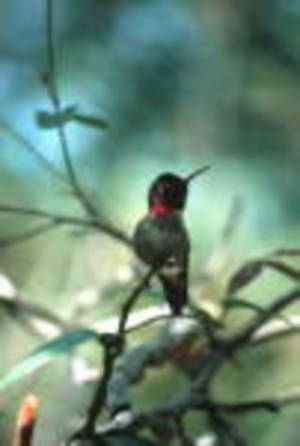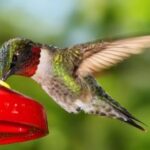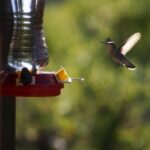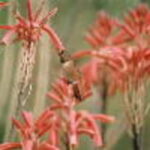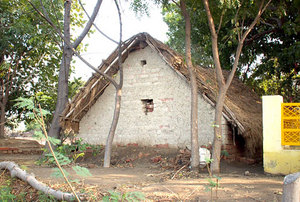The state of Minnesota, whose motto is L’etoile du Nord, meaning “Star of the North” has several species of stars that pay it a visit each May and stay until sometime in September, when there migration urges move them farther south. Of course, I am speaking of hummingbirds. Minnesota hummingbird enthusiasts have the opportunity to enjoy at least five species of these tiny birds; they are the Ruby-throated Hummingbird, the Rufous Hummingbird, the Calliope Hummingbird, thee Magnificent Hummingbird and the Anna’s Hummingbird. Being proper hosts to these tiny visitors is not very hard, it only takes a hummingbird garden loaded with the proper types of blooming plants and/or a hummingbird feeder or two.
Identifying these tiny visitors can be time consuming, and can often get confusing at best, but with a little help, surely it can be done. Each species has a feature, usually involving a color that helps it to be identified or at least to be able to tell it apart from the other species. For identification purposes, the easiest species to begin on is the Ruby-throated Hummingbird. There is two reasons for this, one being that this is the most commonly seen hummingbird in all of the nation and two, because of the bright ruby-red throat that males proudly display. The male also has a forked tail, which is not seen on any other species commonly seen in Minnesota. Unfortunately, the female Ruby-throated Hummingbird is not as easily identified as the male. But with careful observations, even she can be identified in a crowd. This bird has an emerald green back, as does her male counterpart, a white breast and her white-tipped tail are rounded.
The next species of hummingbirds in Minnesota to identify is the Rufous Hummingbird. This species is identified by the rufous color of most of the feathers that cover its body. Both sexes have a majority of its body that is rufous color including the crown, tail and both sides of the male and the tail feathers of the female. However, the most outstanding feature found on the male of this species is its brightly colored orange-red throat. Both male and female Rufous Hummingbirds have white breasts and green backs, even though some males may have rufous colored feathers mingled amongst the rufous colored feathers covering their back.
The Calliope Hummingbird is the next hummingbird to identify in Minnesota. Other than being the smallest species of hummingbirds in Minnesota, the male of this species is once again the most identifiable, with its outstanding feature being its throat, which is white with purple feathers throughout it, creating a “whiskered” effect. The male also has a metallic green back and crown. The female Calliope Hummingbird is also tiny in size, and has a green back and crown, although they are not as brightly colored as the metallic green of the male. These females also have white throats, but no whiskered effects, just darker looking streaks created by darker feathers combined with the white feathers, buff colored feathers down their sides and their tail feathers have white-tipped corners.
The largest species of hummingbirds to visit Minnesota is the Magnificent Hummingbird. Males of this species weigh in the neighborhood of 7.7 grams and females weigh slightly less, usually about 6.4 grams. If size cannot be used to identify these hummingbirds then we will have to look for anther outstanding feature, such as the male’s purple colored forehead and crown, its dark green back or even its black breast. The female, on the other hand, looks nothing like her male counterpart with her olive green colored crown and back, a gray throat that is lightly streaked and pearl gray tipped tail feathers.
The Anna’s Hummingbird is another of the larger species seen in Minnesota. Although it is not as large as the Magnificent Hummingbird, the male of this species will usually, weigh close to 4.3 grams, making it larger most of the other hummingbirds in Minnesota. Even though this species of hummingbirds are somewhat larger than most of the other hummingbirds in Minnesota, size may not be a good indicator of which species a hummingbird in question may actually be. To be sure, it is better to add the size to other factors, such as colored markings. The male Anna’s Hummingbird has a gray breast, a rosy-red throat, crown, and a back that is metallic green. The female Anna’s Hummingbird has a lighter gray breast, a less brilliant green back and its throat is white with red spots.
To attract these many species to landscapes in Minnesota, it is important to know what plants to include in a hummingbird garden. If the plants chosen do not attract these tiny, beautiful birds or if the plants chosen are preferred by hummingbirds, but will not do well in Minnesota, then the hummingbird garden will be a failure. For flowers, consider planting Bee balm, Bleeding heart, and Canna lily, Dahlia, Four O’clock, Fuschia, Impatiens and Sweet William. For vines, some to consider are Cardinal climber, Honeysuckle, Trumpet vine and Morning glory. For trees to add to the landscape, use Apple, Crabapple and Hawthorne and for shrubs use Azaleas and Beauty bush.
Hummingbirds in Minnesota
The state of Minnesota, whose motto is L’etoile du Nord, meaning “Star of the North” has several species of stars that pay it a visit each May and stay until sometime in September, when there migration urges move them farther south. Of course, I am speaking of hummingbirds. Minnesota hummingbird enthusiasts have the opportunity to enjoy at least five species of these tiny birds; they are the Ruby-throated Hummingbird, the Rufous Hummingbird, the Calliope Hummingbird, thee Magnificent Hummingbird and the Anna’s Hummingbird. Being proper hosts to these tiny visitors is not very hard, it only takes a hummingbird garden loaded with the proper types of blooming plants and/or a hummingbird feeder or two.
Identifying these tiny visitors can be time consuming, and can often get confusing at best, but with a little help, surely it can be done. Each species has a feature, usually involving a color that helps it to be identified or at least to be able to tell it apart from the other species. For identification purposes, the easiest species to begin on is the Ruby-throated Hummingbird. There is two reasons for this, one being that this is the most commonly seen hummingbird in all of the nation and two, because of the bright ruby-red throat that males proudly display. The male also has a forked tail, which is not seen on any other species commonly seen in Minnesota. Unfortunately, the female Ruby-throated Hummingbird is not as easily identified as the male. But with careful observations, even she can be identified in a crowd. This bird has an emerald green back, as does her male counterpart, a white breast and her white-tipped tail are rounded.
The next species of hummingbirds in Minnesota to identify is the Rufous Hummingbird. This species is identified by the rufous color of most of the feathers that cover its body. Both sexes have a majority of its body that is rufous color including the crown, tail and both sides of the male and the tail feathers of the female. However, the most outstanding feature found on the male of this species is its brightly colored orange-red throat. Both male and female Rufous Hummingbirds have white breasts and green backs, even though some males may have rufous colored feathers mingled amongst the rufous colored feathers covering their back.
The Calliope Hummingbird is the next hummingbird to identify in Minnesota. Other than being the smallest species of hummingbirds in Minnesota, the male of this species is once again the most identifiable, with its outstanding feature being its throat, which is white with purple feathers throughout it, creating a “whiskered” effect. The male also has a metallic green back and crown. The female Calliope Hummingbird is also tiny in size, and has a green back and crown, although they are not as brightly colored as the metallic green of the male. These females also have white throats, but no whiskered effects, just darker looking streaks created by darker feathers combined with the white feathers, buff colored feathers down their sides and their tail feathers have white-tipped corners.
The largest species of hummingbirds to visit Minnesota is the Magnificent Hummingbird. Males of this species weigh in the neighborhood of 7.7 grams and females weigh slightly less, usually about 6.4 grams. If size cannot be used to identify these hummingbirds then we will have to look for anther outstanding feature, such as the male’s purple colored forehead and crown, its dark green back or even its black breast. The female, on the other hand, looks nothing like her male counterpart with her olive green colored crown and back, a gray throat that is lightly streaked and pearl gray tipped tail feathers.
The Anna’s Hummingbird is another of the larger species seen in Minnesota. Although it is not as large as the Magnificent Hummingbird, the male of this species will usually, weigh close to 4.3 grams, making it larger most of the other hummingbirds in Minnesota. Even though this species of hummingbirds are somewhat larger than most of the other hummingbirds in Minnesota, size may not be a good indicator of which species a hummingbird in question may actually be. To be sure, it is better to add the size to other factors, such as colored markings. The male Anna’s Hummingbird has a gray breast, a rosy-red throat, crown, and a back that is metallic green. The female Anna’s Hummingbird has a lighter gray breast, a less brilliant green back and its throat is white with red spots.
To attract these many species to landscapes in Minnesota, it is important to know what plants to include in a hummingbird garden. If the plants chosen do not attract these tiny, beautiful birds or if the plants chosen are preferred by hummingbirds, but will not do well in Minnesota, then the hummingbird garden will be a failure. For flowers, consider planting Bee balm, Bleeding heart, and Canna lily, Dahlia, Four O’clock, Fuschia, Impatiens and Sweet William. For vines, some to consider are Cardinal climber, Honeysuckle, Trumpet vine and Morning glory. For trees to add to the landscape, use Apple, Crabapple and Hawthorne and for shrubs use Azaleas and Beauty bush.
